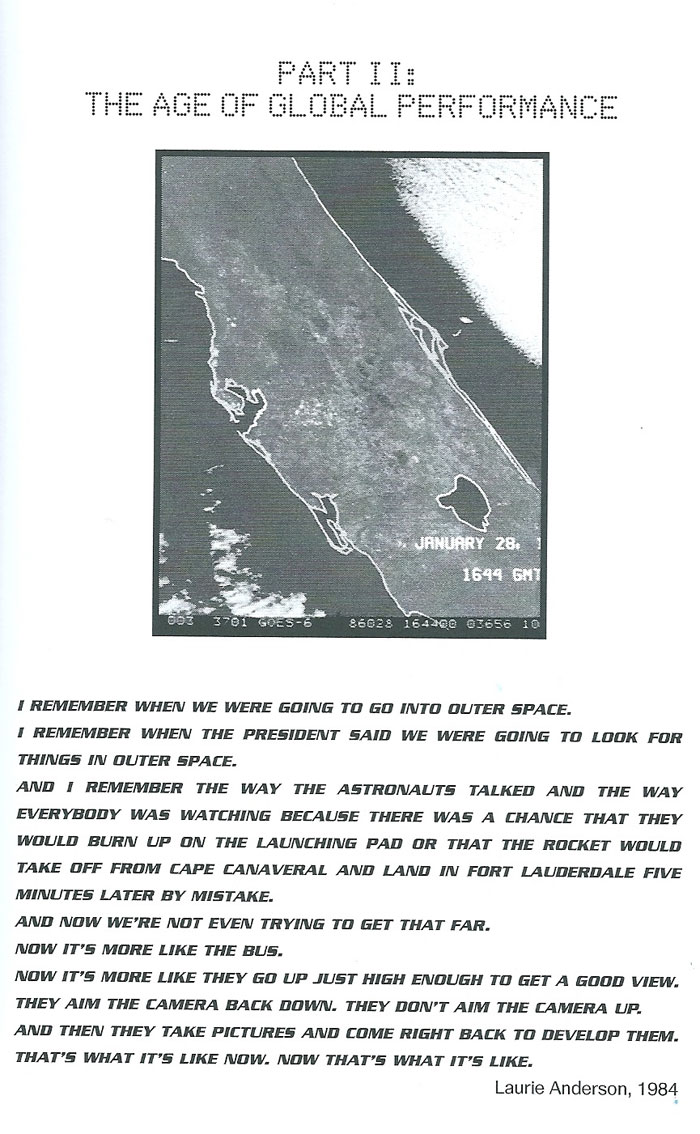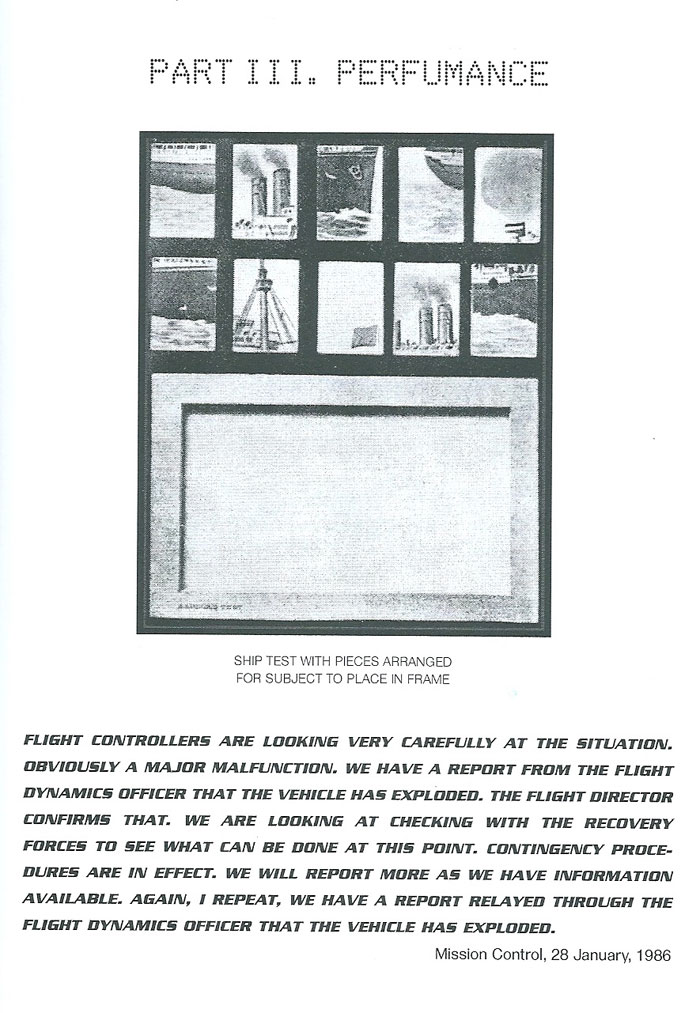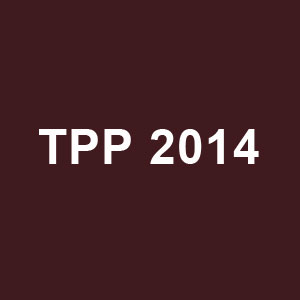You might need your own shuttle to navigate the broad constellation Jon McKenzie presents in his book Perform or Else (Routledge, 2001). His critical analysis of current-day performance culture spans not only cultural and performance studies in academia, but also the realms of organizational practices in the business world (from private companies to government institutions), all the way to technology’s transforming power on a global scale. Showing how cultural, organizational and technological performances intertwine and affect one another, McKenzie builds a substantial case for how the pressure to perform underlies (in varying and often unconcerted ways) widely divergent domains of contemporary life. From principles of corporate management to evolving academic practices to government investments in technology, the criteria of performance has become sovereign.

This “performance strata” that connects us across continents and disciplines has heretofore mostly been examined topically and in isolation from its parallel aspects in seemingly unrelated schemes. Yet McKenzie argues that the domain-specific concepts of cultural efficacy, organisational efficiency and technological effectiveness all intersect with one another as well as share key characteristics in common. From feedback loops to systems theory, these paradigms travel and multiply, merge and explode. Yet their practices use terminology from the theater, converging around the word performance: “What has occurred has been the articulation and rapid extension of performance concepts into formalized systems of discourses and practices, into sociotechnical systems that have themselves become institutionalized first within the United States and then subsequently worldwide” (13). He thus starts off on an endeavor he describes as the attempt “to rehearse a general theory of performance” (88).
Indeed, the fact that various performance paradigms emerged more or less simultaneously across seemingly unrelated domains indicates that something significant is underfoot. Acknowledging the extraordinary breakthroughs in industry, science, teaching, transportation and technology since WWII, all combining to create the phenomenon of globalization, McKenzie asks, “And yet what if this explosion in knowledge was itself ‘performative’? What if the diversification and proliferation of researchers, projects, and fields over the past fifty years signal not only a quantitative leap in research initiatives, but also a qualitative mutation in what we call knowledge, the becoming-performative of knowledge itself?” 13-14).
In The Postmodern Condition, Lyotard argued that the grand narratives (progress, liberation, equality, etc) of bygone eras used to legitimatize knowledge have been replaced by the principle of efficiency. Knowledge in postmodernity is legitimatized by the system’s performance – be it organizational, cultural, or technological. Instead of opposing knowledge and power in the belief that reason, understood as objective and universal, would harness and subdue irrational and oppressive powers into submission, postmodern pragmatism aligns knowledge with power by reformulating them as information and production, respectively (15). Taking his cue from Lyotard and in dialogue with Foucault, McKenzie declares, “Performance will be to the twentieth and twenty-first centuries what discipline was to the eighteenth and nineteenth, that is, an onto-historical formation of power and knowledge” (18).
Although McKenzie assures us that forms of discipline and panoptic surveillance are still alive and well in numerous ways, the shift from discipline to performance can barely be overestimated. Whereas disciplinary mechanisms are modelled on repression, performative mechanisms are modelled on expression, excess, and multiplicity. “Performance produces a new subject of knowledge . . . Hyphenated identities, transgendered bodies, digital avatars, the Human Genome Project – these suggest that the performative subject is constructed as fragmented rather than unified, decentered rather than centered, virtual as well as actual” (18). Traditional technologies of knowledge – the alphabet, writing, the book, the printing press – have been superseded by digital media and its binary code, allowing an exponential expansion of information to occur, circulate, and be networked across geographical and institutional boundaries.

McKenzie then proceeds to give close-up examinations of specific ways in which knowledge practices have mutated, beginning in academia with the application of theatrical terminology in the study of cultural practices. The history of this phenomenon is already well-documented, having given rise to the field of Performance Studies whose early formations began in the 1950s. In order to show the points of contact between performance practices within academia and in the world at large, McKenzie notes that the study of cultural performance and its relation to social norms is primarily a matter of gauging the former’s efficacy. Cultural performance necessarily interacts with social structures, either by reinforcing and affirming them or by attempting to resist or transform them. Yet one could say that a distinct urgency or imperative forms the field of Performance Studies, one that emphasizes cultural performance’s subversive potential, as evidenced by the central role given to theories of liminality. (Any urgency or imperative to use performance to bolster or undergird social structures is more or less absent from Performance Studies.)
McKenzie describes the formation of the study of cultural performance as a series of conceptual shifts that happened across several different disciplines between 1955 and 1975, ranging from theater studies to linguistics, communication, anthropology, dance and the visual arts, all the way to political science and social activism: From the playscript to the actor’s body, from art to the art-making process, from a tale to its context, from grammatical structures to the act of utterances, from Establishment politics to a genuine concern for social relations, “there was an attempt to pass from product to process, from mediated expression to direct contact, from representation to presentation, from discourse to body, from absence to presence” (37-38). This primacy of physicality reached its zenith during the cultural upheavals of the late 1960s, with masses of people taking to the streets to oppose institutionalized power with the sheer presence of their bodies.
However, the theory explosion of the mid-1970s had a profound impact upon this paradigm. The wide-spread infusion of Continental philosophy into the arts, activism and academia returned theater to the body politic. Binary oppositions such as discourse/body and absence/presence were challenged as belonging to a conceptual hierarchy that remained subservient to what Derrida identified as “logocentrism.” Speaking instead of writing or using one’s body instead of one’s language does not in itself allow one to escape from the overriding structures of knowledge/power. French post-structuralism thus ushered in the reinstatement of theory and the text as legitimate sites of cultural performance. Moreover, this return to theory through a critique of presence left the theater – the instigator of the cultural performance studies movement – by the wayside. “If theater helped performance scholars ‘see’ performance as embodied practices, critical theory challenged this vision and, indeed, the very field of its theoretical visibility, its form as presence” (41). Nevertheless, this further shift within the paradigm did not alter the fundamental imperative of efficacy, but rather displaced transgression from without by resistance from within, acknowledging our immersion in the system or structures we wish to oppose.
Passing on to his next site of knowledge/practice mutation, McKenzie tackles an examination of organizational efficiency’s evolution in the business world. Whereas the application of scientific principles to the question of management revolutionized American industry at the turn of the century thanks to Frederick Winslow Taylor’s ground-breaking theory, changing landscapes in the post-war era called for new forms of organization, leading to the emergence of Performance Management. While the goal of enhanced efficiency remains the same, Performance Management opposes itself to Taylor’s principles of scientific management by emphasizing diversity and intuition over uniformity and rationality, thus subtly but radically changing how maximum performance can be achieved. That a major shift had occurred was apparent by the 1960s when organizations begin actively investing in the employee and allowing each individual to effect changes in the way the company operated rather than “tayloring” each individual to the sovereign functioning of the company machine. Instead of merely evaluating performance in a disciplinary model, Performance Management strives to encourage and enable performance within a partnership model. Again, this shift recalls the displacement from exterior transgression to interior transformation, a strategy that works to integrate diversity and multiplicity rather than oppose them. Such unprecedented openness in structural organization relies upon methods such as feedback, wherein outside forces are not only allowed but even solicited in order to affect company policy.
Another factor which contributed heavily to changing organizational practices is the deindustrialization of the US and the subsequent rise of a service-and-information-oriented economy. With the increasing prevalence of technology in the workplace, the decision-making processes are diffused and sometimes reversed, often working from the bottom up. The omnipresence of electronic devices also contribute to the dissolution of divisions between work and play. With creativity, intuition and initiative being zealously fostered at work, the digital invasion that renders our physical location irrelevant results in the merging of labor and leisure. Distinctions and hierarchies thus crumble from within Performance Management, issuing a different challenge. From a science to an art, the evolution of organizational practices unite knowledge and power in the call to perform.
The ever-increasing role that technology plays in Performance Management leads to McKenzie’s third area of overlapping investigation, a site he calls Techno-Performance. It is in this third sphere that questions of absence/presence and language/body become the most troubling: “At the turn of the twenty-first century, the citationality of discourses and practices is passing across an electronic threshold, a digital limen. Words and gestures, statements and behaviors, symbolic systems and living bodies are being recorded, archived, and recombined through multimedia communication networks. Liminal and liminoid genres are becoming cyberspatial, flighty, liminautic” (94). In technology, it becomes most apparent that concepts of performance can never be generalized but are, by their very nature, situated in a context-specific environment. Performance cannot be abstracted or defined; performance does not exist, it performs.
McKenzie points out that, far from being a phenomenon exclusive to the humanities, performance paradigms are absolutely essential to the hard sciences, including technology and engineering. Scientific knowledge is obtained through hypotheses, tests, and experiments, whose repeated performance provides the proof for the proposed theory. Performance supplies feedback that can affect, alter, or annul the prediction. In fact, computer evaluation relies so heavily upon intuitive techniques that some suggest it cannot be considered to be a science at all. Similarly, Eugene Ferguson argues that engineering and design are more of an art than a science, as their reliance upon a large range of free judgments is what determines the result (112). Performance is thus an integral part of scientific practice as well, once again related to effectiveness.
Techno-Performance is also the site where performance becomes a matter of the state, at least in terms of US history. McKenzie quotes Stuart Leslie, who writes, “For better or worse, the Cold War redefined American science. In the decade following the Second World War, the Department of Defense became the biggest single patron of American science” (101). Indeed, social forces are intimately related to technology, from the wide-reaching political pressures that led to the arms race and the subsequent demand for technological advances down to the proliferation of individual, user-based interfaces. Any technological project must obtain backing from the realms of finance, politics and society before it can become a reality, and here McKenzie gives multiple examples of projects that never reached fruition because of changing social or political moods. On the other hand, in the case of what McKenzie calls the “full-blown emergence of Techno-Performance,” the project to infuse the educational system with $900 million in the form of the National Defense Education Act of 1958 was a direct response to a national emergency: that of the “missile gap” between the US and the Soviet Union (125). The effects of the perceived political emergency in the MIA complex have now become part and parcel of our daily lives. Reaching even beyond the astounding invention of the World Wide Web, the unprecedented technological advances of the post-war era led to the general viability of technological devices on the commercial market.

While the journey through these various performance paradigms and their joint orchestration is a remarkable feat in itself, McKenzie is simply laying the groundwork for an exploration into what these combined forces have produced: a “global performative matrix” (131). Commenting on Heidegger’s distinction between techne and technology, which he says represents the cross-criticisms exchanged between the humanities and the sciences, he picks up on Heidegger’s description of technology’s mode of revealing as a “challenging forth” [Herausfordern], claiming that “the world is being challenged forth to perform – or else” (158). The overriding force that gathers the paradigms of Performance Studies, Performance Management, and Techno-Performance together corresponds to what McKenzie calls “the power of performance” (159).
In addition to Heidegger, McKenzie cites Herbert Marcuse – Eros and Civilization (1955) – and his “performance principle” as well as Jean-François Lyotard – The Postmodern Condition (1979) – and the language game that Lyotard calls “performativity.” According to Lyotard, performativity is what legitimatizes power and normalizes activities. Responding to the demand for efficiency, performativity displaces grand narratives in favor of plurality and reciprocity. Education is replaced by job training; knowledge is validated by its usefulness. McKenzie notes that while acknowledging performativity as a force of transformation in society, both Marcuse and Lyotard describe it as a normalizing mode of power and knowledge that bends the knee to economic and technical efficiency.
This assertion is particularly unpopular in McKenzie’s own stratosphere – that of Performance Studies, as academia’s approach to performance has systematically emphasized the liminal or transgressive nature of ritual and performance. Suggesting that various performance paradigms regulate entire social, economic and political systems disrupts notions of performativity as inherently subversive. McKenzie explains that it is for this very reason that Marcuse’s and Lyotard’s reflections on the topic have been curiously bypassed by a wealth of scholars devoted to the study of performance. This is also true, though to a lesser degree, of the reception of Judith Butler’s works, as she poses performativity as both transgressive and resistant on the one hand while normative and punitive on the other. McKenzie proposes to extend this opposition in a way that could account for the convergence of both sides through a general theory of the power of performance: “This theory rehearsal . . . suggests that discursive performatives and embodied performances are the building blocks of an immense onto-historical production, one which we will soon explore as the performance stratum . . . a power/knowledge formation that is a half-century old and growing more powerful and knowledgeable every day” (171).
This performance stratum combines words and acts, speaking and seeing, discourse and practice into a heterogeneous network of disjunctive elements. What McKenzie points out is that the tensions between the different paradigms all take place within the same performance system: “Performatives and performances are our system and our style, our ways of saying and seeing . . . [they] are in the midst of becoming the onto-historical conditions for saying and seeing anything at all” (176). Whether body or speech, everything is performance/performative. Yet these forms cannot be harmonized: they remain distinct, incompatible, sometimes even hostile to one another. They are held together by force: “As heterogeneous forms of knowledge, discursive performatives and embodied performances presuppose each other, and because these forms do not conform or correspond, their integration must be understood at another level, that of force relations, i.e., power” (177).
The rise of performance cannot be lifted from its global context, one that accounts for changing modes of subject/object, geopolitics, economics, knowledge production, media archives, desire, and power mechanisms. In relation to all these factors, McKenzie makes a point-by-point description of how performance has displaced discipline in each node of the social formation network. Although forces of discipline are still present, the various elements of the power structure have radically changed over the past 50 years in ways that have unmistakable affinities with performance paradigms. Hybrid identities, cultural diversity, multinational companies, global digital infrastructures, wide-spread economic speculation, perpetual education, audiovisual archiving, and the modulating and competing desire to exceed all converge in our very impulse to protest and transgress limits or norms. In fact, constant transformation has become part of our software design. Electronic, interactive interfaces have replaced the traditional forms of knowledge transmission. We are now programmed to perform instead of conform.

Thus McKenzie concludes that we must shift our focus “from the forms of knowledge to the forces of power” which ultimately determine the former (201). He suggests that the only way of doing this is would be to shift our very senses, privileging queer sensory inputs over the theoretical senses of sight and hearing. This queer element he names “Perfumance: the odor of things and words, the sweat of bodies, the perfume of discourse . . . the ruse of a general theory” (203). Paying homage to the trouble Butler wrecked on the term “performative,” McKenzie advocates for a disturbance of signification in and of the performance stratum at large. And here he plays on genres of thinking, referring to Nietzsche’s “gay science” in which the profound and the ridiculous are but two sides of the same fragile membrane that divides the sensible from the senseless. “The coming together of discourses and practices from different performance paradigms creates countless incongruities, odd paradoxes, and even outright absurdities – and from this gathering there intermittently arises a certain nonsensical sense, a non-sense that may explode in laughter” (229). McKenzie then adds, “There are some thoughts that require laughter in order to be thought at all, and perfumance is one of them” (230). In writing about thought that requires laughter – that navigates between sense and scents – it is no surprise to see the name of Avital Ronell jump out from the page in this theory test drive. Perfumances are tricky; they don’t situate themselves on one side or the other of the limen but criticize and affirm at the same time. “Perfumance is a gathering arrangement of forces, an emergent folding of the outside inside, one that generates new forms of being and history – and emerging patterns of becoming. Perfumance, technopoesis, genre machinic. To reiterate what distinguishes machines and structures: With a machine, the outside inscribes or remarks itself inside, and the inside outside . . . A general theory of performance is therefore inseparable from a generalized technology, a becoming-machinic of the world that reformats all reading machines” (261-262). Ending with an allusion to Nietzsche’s superman, McKenzie concludes Perform or Else with a query: What unchartered horizons hover in the ever beyond of this age of global performance?

Today, McKenzie’s performance practices are the proof of his theory. In anticipation of his keynote address at the upcoming Theater, Performance, Philosophy conference, we asked him the following questions:
Since Perform or Else has been published, what do you consider to be some of the most surprising developments in the performance stratum?
Jon: What are surprises? Impossibilities suddenly or slowly giving way, arriving with different intensities and bearing distinct flavors: sweet, bitter, tragic… One began unfolding several months after Perform or Else was published in early 2001, a year of many changes: marriage, sale of family home, return to New York City. On September 9th, I buried my father’s ashes in Florida, and in a downpour walked up Broadway on the 10th, and then watched the Towers fall in flames on the 11th, a day I was to teach experience design at NYU. This event and the subsequent war on terror triggered a dramatic set change on the world stage of global performance, a substantive shift in the operations of performative power: the sudden establishment of executive performativity, interrogation via torture, homo sacre data bodies, what I call the society of the spectacle of the scaffold, an anachronistic yet very real theater of operations that breaks, rewires, and reframes the media and torture spectacles analyzed by Debord and Foucault. The modalities of global performativity are still emerging, and while Lyotard marked 1945 as a breakpoint, it’s clear that the years 1968, 1989, and 2001 mark the opening of other cracks, as does 2013 with the Snowden leaks. Like subjects, strata molt in unexpected yet iterative ways.
Can you describe your current project DesignLab for us?
Jon: I currently direct DesignLab at the University of Wisconsin-Madison, assisted by our Associate Director Rosemary Bodolay. DesignLab is more than a project; it’s a digital media consultancy for students and faculty, and our nine graduate consultants come from nine different departments. Our mission is to democratize digitality, just as public education began democratizing literacy in the 19th century. Located in the library, we’ve worked with over 1000 students in two years, helping them create in emerging scholarly genres such as video essays, theory comix, and performance lectures. DesignLab consultants focus primarily on conceptual and aesthetic issues, and though we don’t offer classes, we support potentially any project in any course. In many ways, DesignLab is a concrete instantiation of my research, as its structure and interdisciplinary approach merges cultural, organizational, and technological performances, and we operate in the gap between disciplinary and performative knowledge games. We’ve also helped organize a series of Design Summits to connect designers across campus and beyond, and recently I’ve been working with our School of Human Ecology to explore ways of using design approaches to enhance research, teaching, and service campus-wide. Like performance, design is everywhere yet (almost) nowhere studied.

